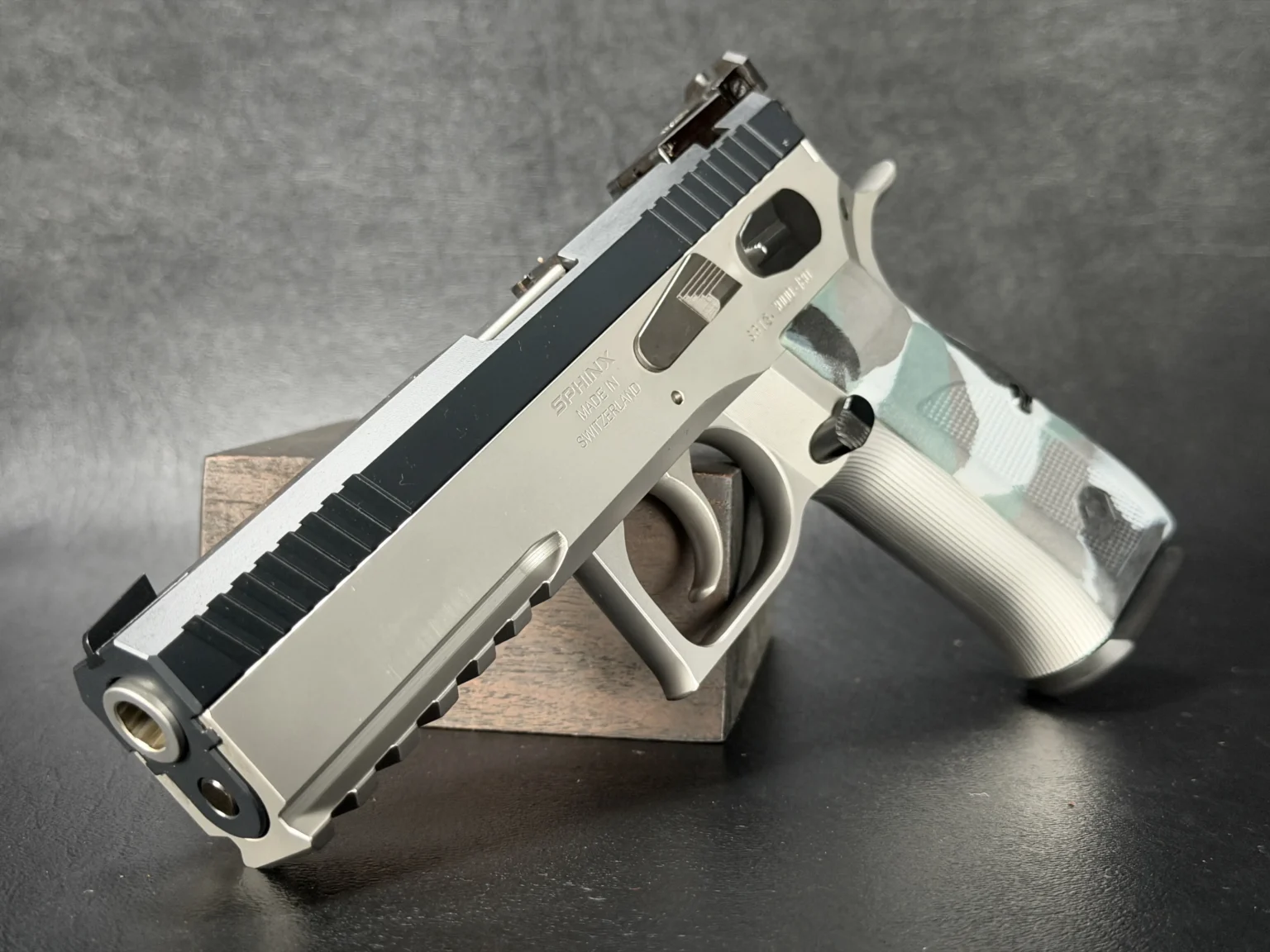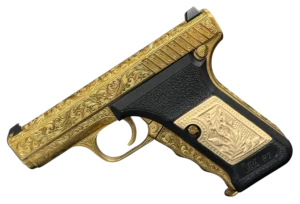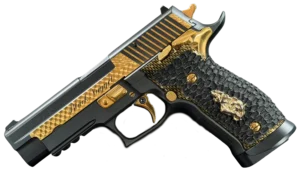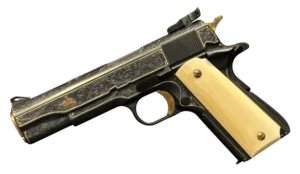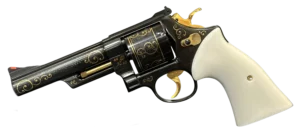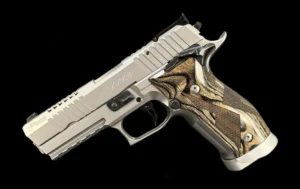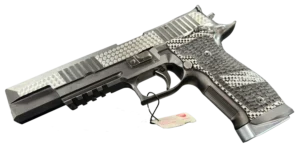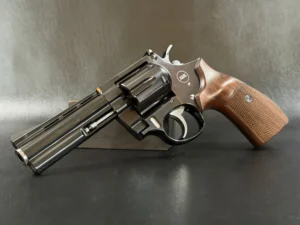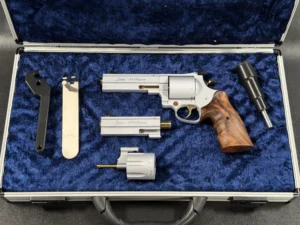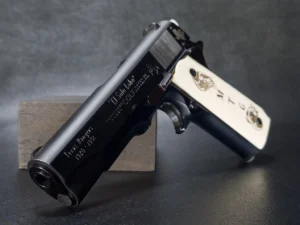Key Takeaways:
- Swiss precision wasn’t just marketing hype: The Sphinx 3000 was machined from solid steel billets, not cast or forged like pretty much every other combat pistol out there. We’re talking about tolerances you’d expect from a watch, not a weapon. Every single gun was hand-fitted by skilled craftsmen after the CNC machines had done their work. That level of precision costs a fortune and takes forever, but it’s also why these guns could shoot groups that would make a custom 1911 jealous. When you picked one up, you could feel the difference in how tight everything fit together.
- It did something most guns can’t pull off: Here’s the weird thing about the Sphinx 3000. It could win IPSC competitions on Saturday and then go into combat on Monday without breaking a sweat. Most race guns are too fragile for real-world use. Most service pistols aren’t accurate enough for serious competition. The Sphinx managed to be genuinely elite at both, which is a lot harder than it sounds. Special forces units and competition shooters were using the same basic platform, just with different accessories bolted on. That versatility is pretty rare in the firearms world.
- Being the best doesn’t guarantee survival: The Sphinx 3000 was probably one of the finest combat pistols ever manufactured, and the company still went under in 2016. It turns out that the market for handguns priced at $ 3,000 or more is quite limited, regardless of their quality. You could buy three or four excellent service pistols for the price of one Sphinx. For most people, that math doesn’t work. The gun was a victim of its own excellence in a way. Too expensive, too specialized, too perfect for a world that mainly needs “good enough.” But for the people who owned them, who understood what they were getting, the Sphinx 3000 was precisely what a combat pistol should be.
You know how the Swiss are famous for watches, cheese, and staying out of other people’s wars? Well, they also made one hell of a handgun. And honestly, it makes sense when you think about it. The same obsessive attention to detail that goes into a Patek Philippe found its way into the Sphinx Model 3000, a pistol that some shooters consider the European answer to a custom 1911.
But here’s the thing about the Sphinx 3000. It wasn’t designed to be produced by the thousands in a massive factory. This was a boutique gun, a custom piece that cost more than your average service pistol and took way longer to build. And that’s precisely what made it special.
Where It All Started
Let’s back up a bit. Sphinx Systems wasn’t always a gun company. When they started in 1976, they were just another Swiss tooling and engineering firm. You know, the kind that makes precision parts for other companies. Boring but profitable. They were also skilled in this area, specializing in sophisticated machining, die casting, and all the CNC processes that Switzerland has perfected over the decades.
Then, in 1989, something interesting happened. They acquired ITM Solothurn, a company that was already playing around with pistol designs. Suddenly, Sphinx shifted from manufacturing parts to producing guns. And not just any firearms, they were working with designs based on the Czech CZ 75, which is legendary in its own right.
The CZ 75 is one of those pistols that gets it right. Low bore axis, excellent ergonomics, and as reliable as gravity. But Sphinx looked at it and thought, “Yeah, but what if we made it better?” Throughout the 1990s, they refined that CZ 75 pattern into their own line, the Sphinx 2000 series. They tightened tolerances, improved ergonomics, and generally took something good and made it great.
The Model 3000, introduced around 2003, was the next step in that evolution. This was Sphinx saying, “Okay, we’ve learned everything we can from refining someone else’s design. Now let’s build something that’s truly ours.”
Built Like a Swiss Watch (Because Of Course)
Here’s where things get interesting. Most modern pistols use cast or forged frames. It’s faster, it’s cheaper, and honestly, it works fine for 99% of applications. However, Sphinx took a different approach with the 3000. They machined the frame from solid blocks of steel. Both the frame and the slide were milled, not cast.
Why does this matter? Well, when you machine something from a solid billet, you can hold tighter tolerances. Way tighter. We’re talking about differences measured in thousandths of an inch. For a watch, that kind of precision is standard. For a combat pistol, it was pretty much unheard of.
Think about what this means in practice. When parts fit together with that level of precision, there’s less play, less movement, less potential for things to go wrong. The slide-to-frame fit on a Sphinx 3000 is tight. Not so tight that it binds up, but tight enough to feel the difference. When you rack the slide, it moves as smoothly as silk. There’s no rattling, no looseness. Everything is precisely where it should be.
The frame itself is actually made from two steel blocks that are permanently assembled. Both the frame and slide are steel, giving the gun a solid, substantial feel. This isn’t a lightweight polymer pistol. When you pick up a Sphinx 3000, you know you’re holding something serious. It’s got heft, but it’s balanced heft. The weight helps manage recoil, and the balance point is right where you want it.
Some of the components were also made from different materials. You may receive a steel upper frame with a steel or titanium lower frame. Titanium appeared sporadically in custom builds, which was unusual for a service pistol. Most guns at the time were still using aluminum or polymer for the grip, but Sphinx was experimenting with exotic materials to balance weight and manage recoil. Titanium is lighter than steel but stronger than aluminum, and it’s costly. But when you’re already building a premium pistol, why not go all the way?
And everything, and I mean everything, was hand-fitted. After the CNC machines did their work, actual human beings assembled and fitted each pistol by hand. This isn’t like screwing together pre-made parts. This is craftsmen spending hours making sure each component works perfectly with every other component. They’d test fit, make micro-adjustments, and test again. The barrel lockup, the trigger components, and the safety mechanisms. All of it was individually fitted to each specific gun.
You can see the difference in how the gun shoots. Accuracy that would be considered excellent in a custom 1911 was standard in a Sphinx 3000. Groups that other pistols could only dream of were routine. Part of that is the tight tolerances. Part of it is the quality of the barrel. Part of it is that low bore axis from the CZ design. However, much of it is the cumulative effect of a hundred small details all done correctly.
The CZ DNA (But Make It Swiss)
You can’t talk about the Sphinx 3000 without mentioning its CZ 75 heritage. The slide rides inside the frame, which is a classic CZ design. This keeps the bore axis low, which means less muzzle flip and faster follow-up shots. It’s one of those design choices that makes sense once you shoot it.
However, while the earlier Sphinx 2000 remained pretty close to the original CZ 75 design aesthetically, the 3000 took its own direction. It has a deliberate, squared-off look that’s distinctly modern. Less curves, more angles. Some people love it, some people think it looks too aggressive. I’m in the first camp, but you know, personal taste and all that.
The squared-off design wasn’t just aesthetic either. It was functional. Those clean lines and flat surfaces made it easier to maintain a consistent grip in different conditions. Less rounded edges meant less chance of your hand slipping if things got wet or you were wearing gloves. The European shooting community has always been more willing to embrace angular, modernist designs in firearms, and the Sphinx 3000 leaned into that aesthetic with conviction.
The action is still pure CZ, though. Double trigger bar, detachable module, that short-recoil operated, locked-breech design using a Browning cam system. The barrel locks to the slide with a single lug through that big ejection port. It’s proven, reliable, and accurate. Sphinx wasn’t about to mess with what works.
What they did change was the ergonomics. The grip angle on the 3000 is slightly different from the CZ 75, optimized for a more modern shooting stance. The texture and contours of the grip were refined based on feedback from competition shooters and military users. Little things, such as where the slide stop sits, how the magazine release is positioned, and the shape of the trigger guard. Everything was tweaked and improved.
The result is a gun that fits. You pick it up, and it feels right. Your hand naturally falls into the correct position. Your trigger finger aligns perfectly. Your thumb naturally rests on the safety. These aren’t accidents. This is the result of careful, deliberate design informed by actual use.
What You Actually Got
When Sphinx rolled out the 3000 in 2003, it was offered in several different configurations. There was the Standard model, which was full-sized with roughly a 4.5-inch barrel. Then there was a Tactical model with a shorter barrel, measuring around 3.75 inches, designed for law enforcement and individuals who wanted something slightly more concealable yet still substantial.
Both versions came with a steel slide and a full dust-cover frame with an integrated accessory rail. This was back when Picatinny rails on pistols were still relatively new, and Sphinx was ahead of the curve in that regard. Low bore line, extended magazine release, ambidextrous safety, and decocker controls. All the modern features you’d want on a combat pistol.
However, there were also the competition versions. The “Modified” or “Open” class pistols. These things were race guns. Extended magazine wells allow for faster reloading. Mounts for red-dot optics were standard on handguns before that. Some came with Doctor red-dot sights already installed and extended capacity magazines. These were purpose-built for IPSC and IDPA competition, and they excelled remarkably well at it.
The competition scene in the early 2000s was dominated by highly customized 1911s and specialized race guns that could cost $5,000 or more. The Sphinx 3000 walked into that world and immediately started placing in major matches. Shooters who switched to it from other platforms reported tighter groups, faster splits, and more confidence in the gun’s reliability. In the IPSC Standard Division, where you’re limited to relatively stock configurations and 9mm or .40 S&W, the Sphinx was a legitimate contender against guns that cost twice as much.
What’s interesting is that Sphinx didn’t have to compromise the gun’s combat worthiness to make it competitive. A lot of race guns are fragile. They’re tuned so tight, lightened so much, that they become unreliable if they get dirty or if you don’t use precisely the correct ammunition. The Sphinx 3000 wasn’t like that. Yes, the competition versions had features that made them better suited for matches, but they were still built on the same rugged platform. You could shoot a game on Saturday, get it dirty, and trust your life to it on Monday.
Funny enough, the same gun that was winning matches on Sunday could also be used by special operations forces on Monday. That versatility is pretty rare. Most competition guns are too fragile for field use, and most service pistols aren’t accurate enough for serious competition. The Sphinx 3000 managed to be both, and that’s a harder balance to strike than it sounds.
The Trigger (Oh, The Trigger)
Let’s discuss the trigger for a moment, as it deserves its own section. The 3000 has a double-action/single-action trigger with an external hammer. Pretty standard setup on paper. But the single-action pull is often described as “exceptionally crisp and light.”
When a gun costs this much and takes this long to build, you’d expect the trigger to be good. But the Sphinx 3000’s trigger was something else. It’s one of those things you can’t really appreciate until you shoot it yourself. Clean break, minimal take-up, short reset. It’s not quite a 1911 trigger, nothing is, but it’s in that conversation.
Competition shooters who used the 3000 in IPSC matches would tell you that the trigger was one of the main reasons they chose it, in a sport where fractions of a second matter, where you’re trying to put rounds on target as fast as humanly possible while maintaining accuracy, trigger quality isn’t just important. It’s everything. A mushy trigger or one with a long reset can cost you a match. The Sphinx delivered a trigger that let shooters perform at their absolute peak.
Even the double-action pull, which is usually heavier and less refined than single-action, was smooth and manageable on the 3000. Not that most people used it much. DA/SA guns are typically carried with the hammer down for safety, and then the first shot is fired in double-action mode. After that, you’re in single-action mode for the rest of the magazine. But knowing that your first shot won’t be dramatically different from your follow-ups is reassuring. Sphinx put effort into both trigger modes, not just the one that would be used most.
The trigger guard was also shaped for a comfortable two-handed hold, which seems obvious now but wasn’t always a standard feature back then. Little details like that add up. When you’re shooting under stress, or when you’re trying to manage recoil on fast splits, having a trigger guard that accommodates a proper modern grip technique matters more than you’d think.
The Price of Perfection
Here’s the reality check. The Sphinx 3000 was expensive. Like, really expensive. Way more than your average service pistol. A Glock or a SIG might cost you $500-$ 800. A decent 1911 might cost $1,000-$ 1,500. A Sphinx 3000? We’re talking several thousand dollars, and that’s for a standard model. Competition versions or custom builds could easily double that.
To put that in perspective, you could buy three or four quality service pistols for the price of one Sphinx 3000. Alternatively, you could purchase a high-quality AR-15 and still have money left over for optics and ammunition. For many shooters, that math doesn’t make sense. And that’s fine. The Sphinx wasn’t for everyone.
Why so much? Well, all that CNC machining takes time. All that hand-fitting takes skilled labor. The materials aren’t cheap either. And when you’re only making a few hundred guns a year instead of tens of thousands, you can’t spread costs across volume. Every hour of labor, every bit of material, every quality control check gets baked into the price of each gun.
Additionally, you’re paying for Swiss labor rates, overhead, and quality standards. Switzerland isn’t a cheap place to manufacture anything, much less a firearm as complex as the one being discussed. The same economic factors that make Swiss watches expensive apply to Swiss guns. You’re not just paying for the product; you’re also investing in its quality. You’re paying for the ecosystem that produces it.
But the people who bought them weren’t complaining. Special forces units picked them up. Elite police units. Serious competition shooters. These weren’t people looking for a budget option. They wanted the best, and they were willing to pay for it. When your life might depend on your sidearm, or when a championship is on the line, price becomes less of a consideration. You buy the tool that gives you the best chance of success.
Every pistol came with an actual test target, showing you exactly how your specific gun performed. Not a generic target, not a representative sample. Your weapon was fired at the factory, with the results included in the box. Usually, a five-shot group at 25 meters or 25 yards, showing sub-2-inch groups. Sometimes better. That’s the kind of attention to detail we’re talking about. It elevated the pistol from just a tool to a certified, performance-guaranteed instrument.
And honestly, that test target was more than just a piece of paper. It was proof. Proof that someone at the factory cared enough, actually, to shoot your gun and verify it met standards. Evidence that the weapon you were holding had been tested and validated. In an industry where a significant amount of quality control relies on statistical sampling, Sphinx tested every single gun individually. That costs money, but it means something.
The Swiss Advantage (And Disadvantage)
There was a “Swiss Made Advantage” marketing campaign that Sphinx utilized. And honestly, it wasn’t just marketing. When something is made in Switzerland, there’s an expectation of quality. That reputation is built on centuries of precision manufacturing, and it’s not undeserved.
The original “Kodiak 3000” model slides were machined from solid billet steel. Frames were crafted from billet, forging, or casting, but always from high-grade materials. Stainless steel, aluminum, titanium. The dedication to material purity and hand assembly meant every custom-made Sphinx pistol was, in a real sense, unique.
But here’s the thing about being a boutique manufacturer in a global market. It’s hard. Really hard. Sphinx Systems operated from 1976 until July 2016, when the company finally dissolved. Forty years is a good run, don’t get me wrong. But the fact that they shut down tells you something about the challenges of making ultra-high-end firearms in small quantities.
They made guns that were technically and functionally superb—probably some of the best pistols ever manufactured. But the market for $3,000+ handguns is limited, and they faced external pressures that eventually became too much. The company’s unique pedigree, originating in tooling and machining before diversifying into firearms in the 1980s, gave it capabilities that few manufacturers could match. But it wasn’t enough to keep them afloat.
What Made It Great (And What Made It Niche)
Let’s be real for a second. The Sphinx 3000 was never going to be a mass-market success. It wasn’t supposed to be. This was a gun for people who understood the difference between good and excellent, and who were willing to pay for that difference.
The manufacturing philosophy centered on mechanical consistency. They weren’t trying to make guns fast. They were trying to make guns right. Every pistol was extensively inspected, tested, and certified. The tolerances were tighter than almost anything else on the market. The accuracy was demonstrably superior to most contemporaries.
But substantially more expensive doesn’t just mean a little more. We’re talking about a pistol that costs as much as three or four standard service weapons. For a department looking to arm 50 officers, that’s the difference between spending $40,000 and $150,000. For most organizations, that math doesn’t work.
For individuals, such as competition shooters and special operations units where every advantage matters, the Sphinx 3000 made perfect sense. It was a tool that could do things other pistols couldn’t. Win matches at the highest levels of IPSC Standard Division competition. Serve as a battle-proven sidearm for special operations forces around the world.
The Legacy
The Sphinx 3000 is no longer in production. When Sphinx Systems closed in 2016, that was it. Companies are now using the Sphinx name, but they’re not the same. The original run of Model 3000 pistols represents a specific moment in firearms history when a Swiss tooling company decided to build the best combat pistol they possibly could, cost be damned.
And they succeeded. The guns they made were exceptional. Ask anyone who owns one, ask anyone who’s shot one, and they’ll tell you the same thing. There’s something special about a Sphinx 3000. The way it feels in your hand. The way it shoots. That trigger. That accuracy.
But here’s the weird thing about perfection. It’s expensive. It’s time-consuming. It’s not scalable. The market doesn’t always reward the best product. Sometimes it rewards the good-enough product that costs a third as much and can be delivered tomorrow instead of next month.
The Sphinx 3000 was the European answer to American custom 1911s, and in many ways, it was a better answer. More reliable, more durable, better ergonomics for most shooters. However, like many “best” things, it was also a niche item.
What You Need to Know
If you’re thinking about tracking down a Sphinx 3000 today, here’s what you should know. They’re not easy to find. When they do show up on the used market, they’re still expensive. Not as expensive as when they were new, but we’re still talking $2,000-4,000 depending on condition and model.
Parts availability is a concern. With the original company gone, if something breaks, you might have trouble finding replacements. The guns are tough; they’re built to last, but nothing is indestructible. Some gunsmiths familiar with CZ 75-pattern pistols can work on them, but it’s not the same as having factory support.
But if you can find one, and if you can afford it, and if you understand what you’re getting into with parts and service, a Sphinx 3000 is still one of the finest combat pistols ever made. It’s a piece of firearms history, a testament to what’s possible when precision engineering meets genuine craftsmanship.
The Bottom Line
The Sphinx 3000 represents something we don’t see much anymore. A gun made without compromise. Not designed to hit a price point, not designed to maximize production efficiency, not intended to be all things to all people. Just designed to be excellent.
It combined Swiss manufacturing precision with proven CZ 75 design principles and modern combat features. It was equally at home on a competition range or in the holster of a special operations soldier. It proved that you could make a pistol that excelled in multiple demanding roles if you were willing to put in the work.
The fact that it was too expensive, too specialized, too niche to survive in the market doesn’t make it any less remarkable. If anything, it makes it more interesting. It’s a reminder that the best product doesn’t always win. Sometimes the best product is just the best product, and that has to be enough.
For the people who own them, for the shooters who competed with them, for the operators who carried them in harm’s way, the Sphinx 3000 was more than enough. It was precisely what a combat pistol should be. Accurate, reliable, well-made, and built to last.
Not many guns can claim that. Fewer still can back it up the way the Sphinx 3000 did.
Would I buy one today if I found one at a reasonable price? Absolutely. Would I recommend it to someone looking for their first pistol, or someone on a budget, or someone who wants a reliable gun for home defense? Probably not. There are better options for those needs, guns that cost less and are easier to maintain.
However, for someone who appreciates precision manufacturing, understands the difference between good and great, and wants something special – something with history, character, and genuine quality – the Sphinx 3000 is hard to beat. It’s not the most practical choice. It’s not the most economical choice.
But sometimes, it’s not about practical or economical. Sometimes it’s about finding that one tool that does exactly what you need it to do, better than anything else can. For that specific need, the Sphinx 3000 proved to be the solution.
And that’s worth something.
Frequently Asked Questions
Nope. Sphinx Systems shut down in 2016, so there’s no new production. You might see companies using the Sphinx name now, but they’re not the same outfit that made the original 3000. If you want one, you’ll have to hunt the used market, and honestly, they don’t come up for sale all that often. When they do, expect to pay between $2,000 and $4,000, depending on the condition and variant of the item.
Depends on what you’re after. If you want a safe queen or a collector’s piece, absolutely. Suppose you’re a serious competition shooter who appreciates precision engineering, yeah, probably. However, if you need a reliable carry gun or a home defense pistol, there are many more practical options available. Parts support is now sketchy, now that the company has gone. Some CZ 75 parts may be suitable substitutes in a pinch, and gunsmiths familiar with that platform can sometimes assist, but it’s not the same as having factory support. You’re buying a piece of history, not a modern production gun with a warranty.
Think of it as what happens when you take a CZ 75, give it to Swiss watchmakers, and tell them money is no object. The basic design is CZ, but everything is tighter, smoother, more refined. The trigger is better. The accuracy is better. The fit and finish are way better. But you’re also paying four or five times as much. The CZ 75 is an excellent gun that has proven itself over the decades. The Sphinx 3000 is that same excellence turned up to eleven. Whether that’s worth the extra cost is up to you.
Primarily 9mm, which is the caliber used by most of the competition and duty models. Some variants were also offered in .40 S&W, although those were less common. The 9mm version is what you’ll most likely find if you’re searching for one today. Given how well it managed recoil and how accurate it was, the 9mm chambering made the most sense anyway.
Check the bore and the slide-to-frame fit. These guns were built tight, so if there’s excessive play or wear, that’s a red flag. Inspect the finish for signs of holster wear or corrosion. Ask about the round count, if possible, though many of these didn’t get fired a lot since they were so expensive. Ensure all controls function smoothly. Verify it comes with at least a couple magazines, because those can be hard to find now. And honestly, if possible, shoot it before you buy. A Sphinx 3000 in good condition shoots like nothing else. If it doesn’t feel special, something might be wrong.


